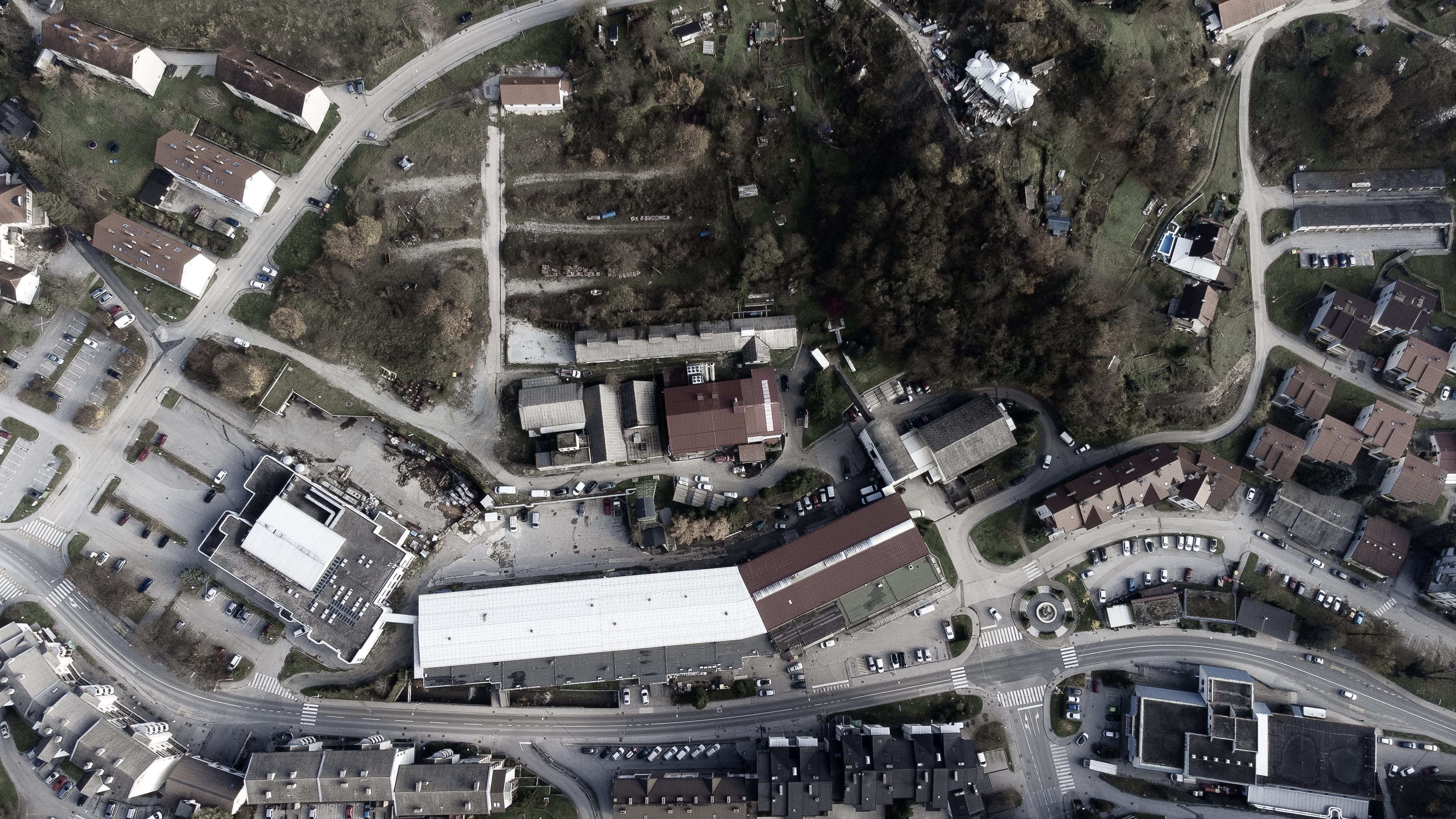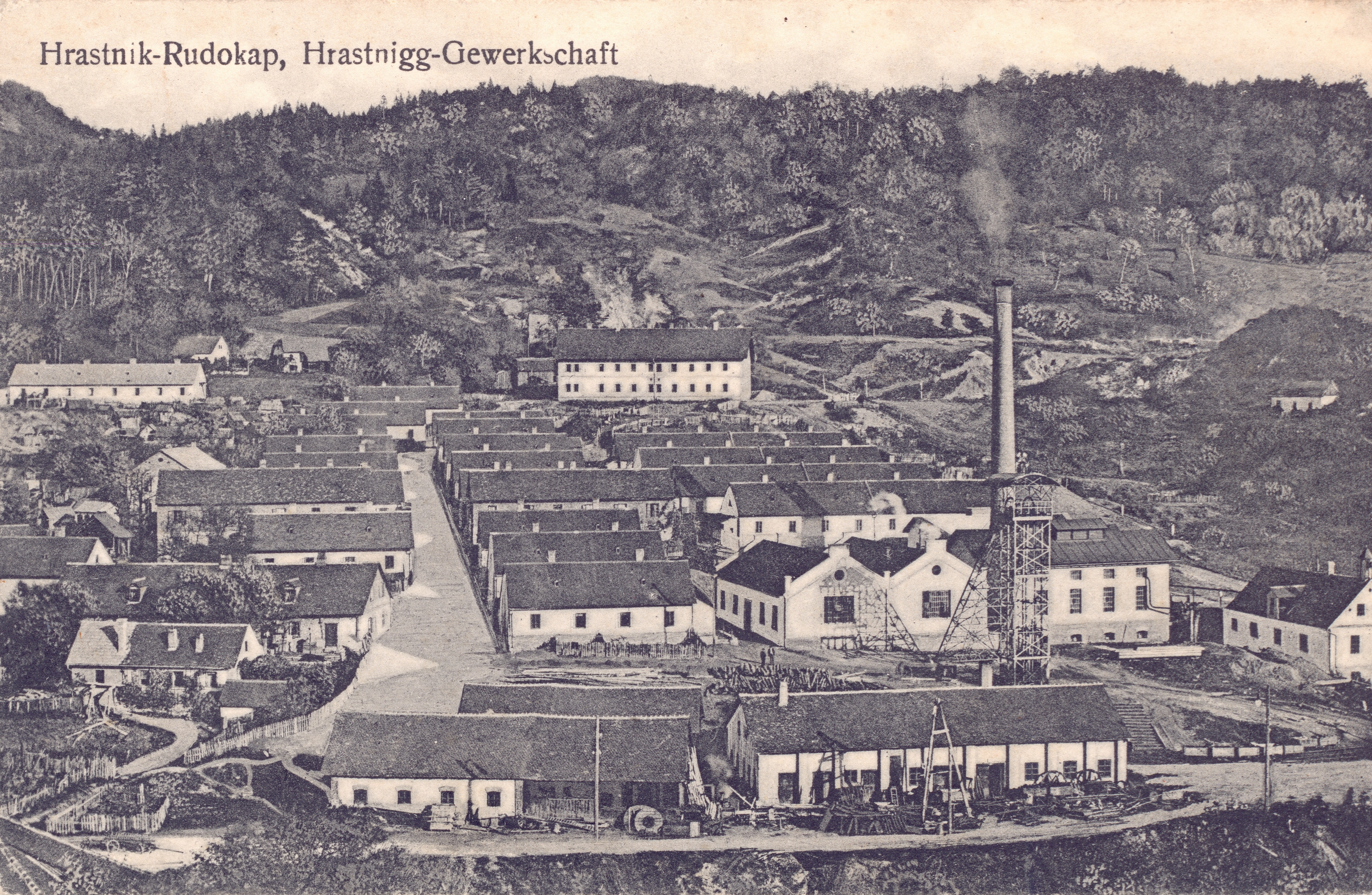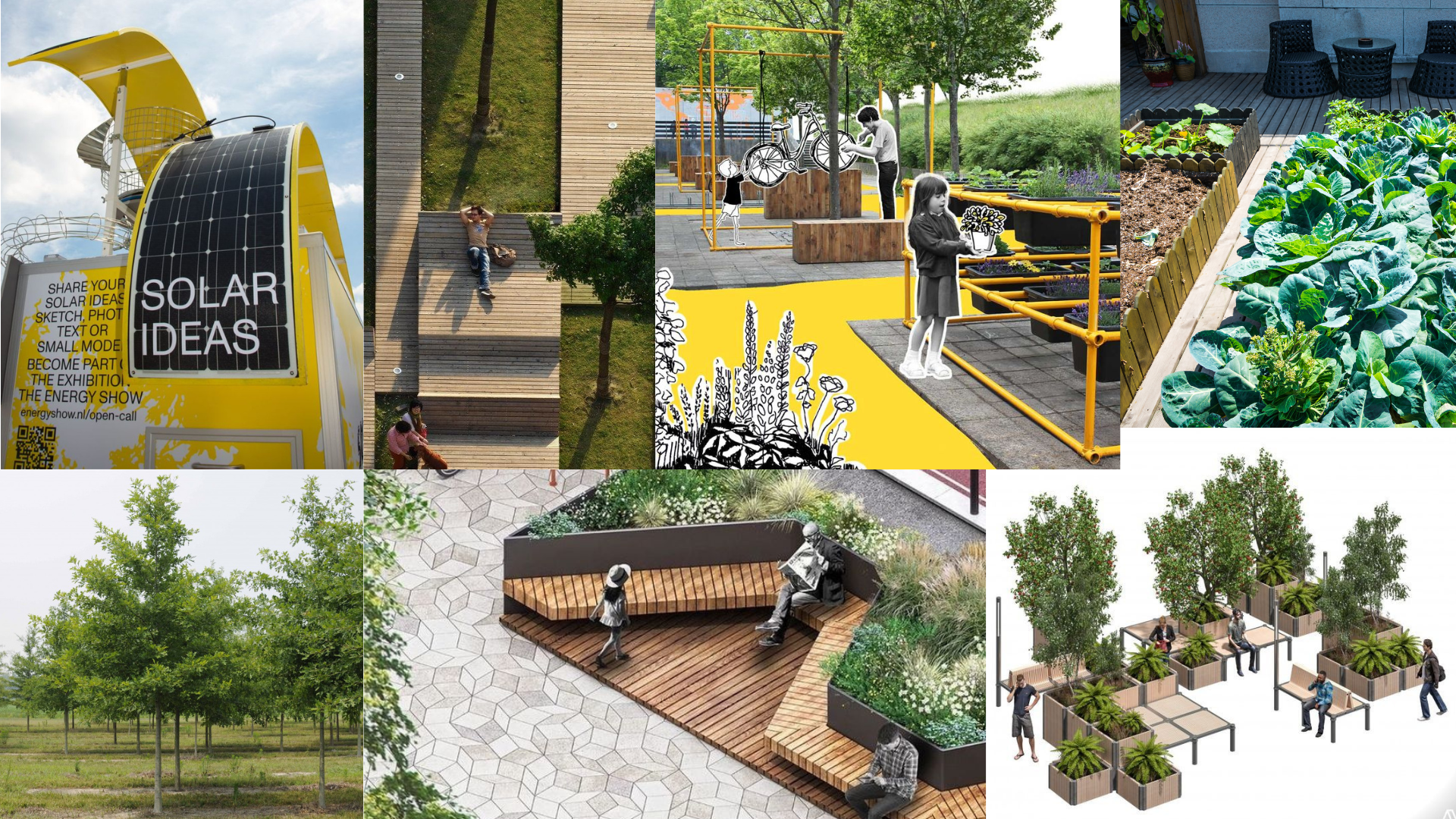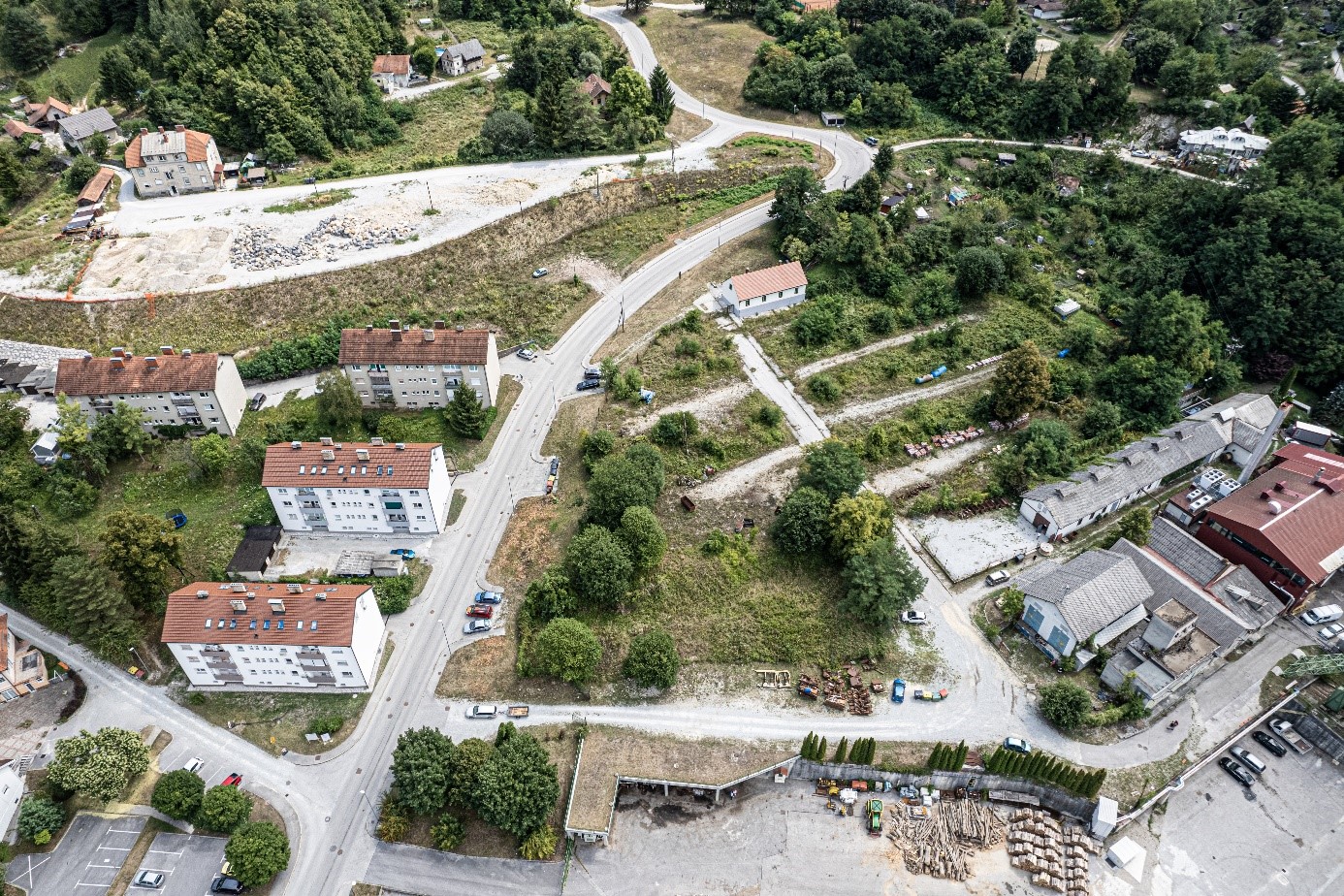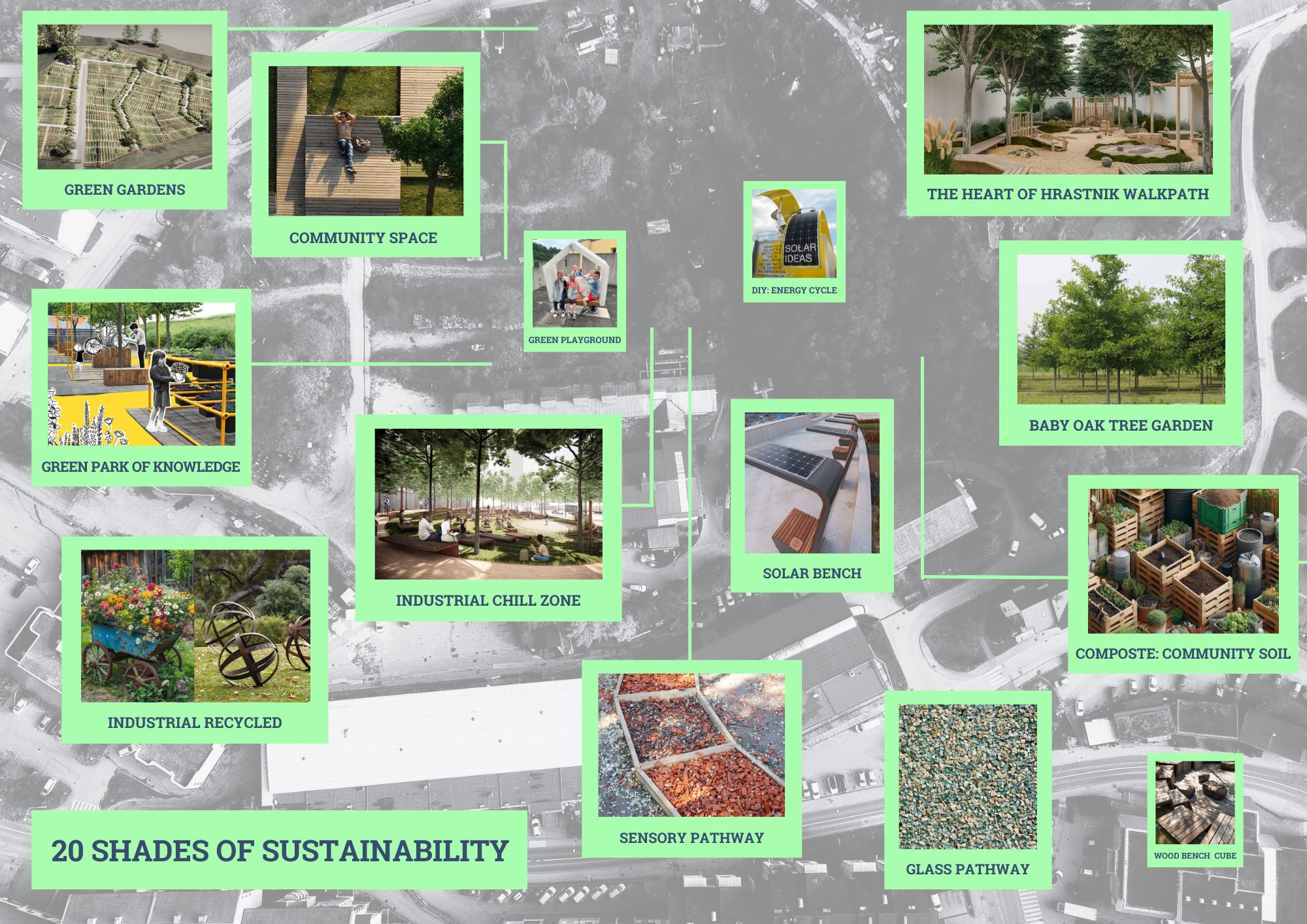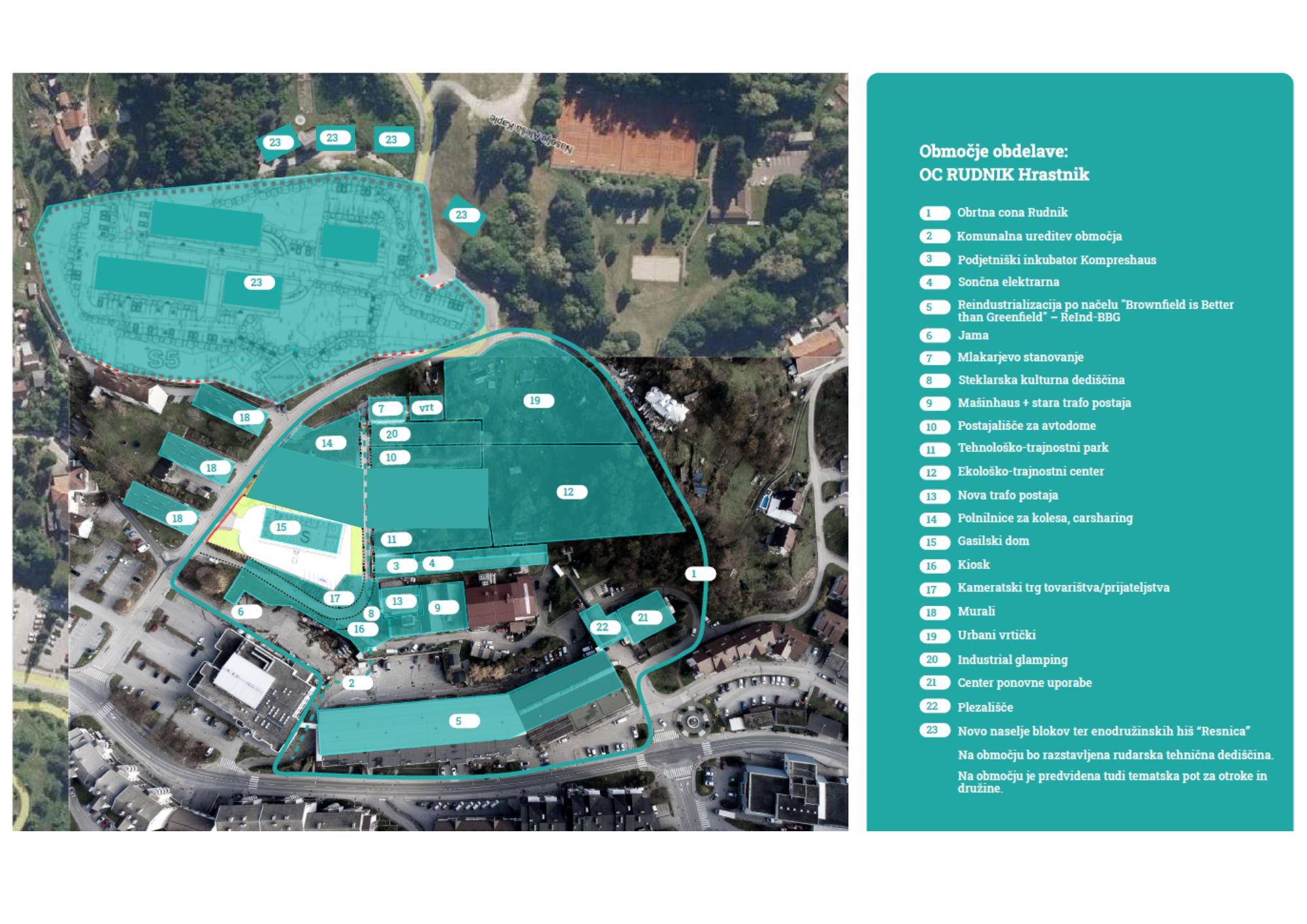Technologically sustainable park
Technologically sustainable park: 20 shades of sustainability
This project transforms abandoned mining areas into a vibrant, sustainable community! Urban gardens, an ecological park, and a tech-inspired play area blend nature, innovation, and eco-friendly living. With a focus on self-sufficiency, renewable energy, and social connection, we’re creating a space for relaxation, learning, and community growth. Join the transformation and help shape the future! "
Slovenia
{Empty}
Early initiative
Yes
Yes
Yes
No
No
034: Hrastnik (SI)
The project aims to transform degraded mining areas into a multifunctional space that blends sustainability, aesthetics, and inclusivity. Its main goal is to create an innovative environment for socializing, relaxation, and education on sustainable energy. The design emphasizes circular economy principles, energy self-sufficiency, and inclusivity, improving quality of life and social cohesion. The upper section will feature urban gardens to promote sustainable agriculture, intergenerational connections, and local food security. A new eco-friendly residential neighborhood will focus on energy self-sufficiency and modern housing that integrates urban living with nature, allowing residents to grow their own food and reduce reliance on industrial food systems. The area will also include an eco-sustainable oak tree nursery park, providing oak saplings to the municipality, promoting biodiversity, and symbolizing resilience to climate change. A composting demonstration field will educate the public on sustainable fertilization and composting practices. The lower part of the area will feature an advanced park with interactive equipment for children, highlighting sustainability and environmental innovation. It will include paths made from recycled materials, energy-generating surfaces, and varied textures to create a sensory experience suitable for all ages and abilities. The target audience includes the local community, particularly children, and the broader public. The project’s goals include improving quality of life, fostering social connections, and promoting sustainable practices. Ultimately, it will create a green space for relaxation, socialization, and knowledge exchange, serving as a model for sustainable, inclusive design in line with the New European Bauhaus.
Urban gardens
Tehnological sustainability park
Residential neighborhood
Responsible environmental management
Community-oriented area planing
The Technology and Sustainability Park is a space that combines education, sustainability, and aesthetics through interactive activities. It offers play equipment encouraging children to explore natural resources such as the sun, wind, and water, while also showcasing renewable energy and circular economy systems. The park aims to inspire young people and families to learn about sustainability in a fun, hands-on way.
The park integrates sustainable design, including flooring made from recycled glass, play areas and pathways from recycled materials, energy-generating surfaces where children produce electricity by moving, and buildings with green roofs to reduce heat islands. These buildings also feature rainwater retention systems and promote water circulation, responding to increasing rainfall. Rainwater collection tanks and solar panels will power park lighting, with boards explaining the renewable energy systems. Benches, fences, and play structures are made from eco-friendly materials like sustainable wood and recycled plastic.
Near the park, a tree nursery will grow over 200 oak seedlings, which will be given as protocol gifts to the municipality. The nursery will include mining heritage elements and a composting area to fertilize the trees. The composting center will educate visitors about producing natural compost from organic waste. This project will also promote sustainable green practices with the municipality's logo.
An urban gardening network will allow residents to rent plots for growing food, encouraging local self-sufficiency. This initiative will promote social interactions, intergenerational collaboration, and the sharing of knowledge about sustainable living. Residents can cultivate vegetables, fruits, and herbs, reducing their reliance on industrial food production while enjoying a space for relaxation and connection with nature.
The park integrates sustainable design, including flooring made from recycled glass, play areas and pathways from recycled materials, energy-generating surfaces where children produce electricity by moving, and buildings with green roofs to reduce heat islands. These buildings also feature rainwater retention systems and promote water circulation, responding to increasing rainfall. Rainwater collection tanks and solar panels will power park lighting, with boards explaining the renewable energy systems. Benches, fences, and play structures are made from eco-friendly materials like sustainable wood and recycled plastic.
Near the park, a tree nursery will grow over 200 oak seedlings, which will be given as protocol gifts to the municipality. The nursery will include mining heritage elements and a composting area to fertilize the trees. The composting center will educate visitors about producing natural compost from organic waste. This project will also promote sustainable green practices with the municipality's logo.
An urban gardening network will allow residents to rent plots for growing food, encouraging local self-sufficiency. This initiative will promote social interactions, intergenerational collaboration, and the sharing of knowledge about sustainable living. Residents can cultivate vegetables, fruits, and herbs, reducing their reliance on industrial food production while enjoying a space for relaxation and connection with nature.
The key goal of the project is to create an aesthetically designed space that provides a high-quality experience for all generations while fostering positive emotions, nurturing cultural identity, and encouraging sustainable behavior. The area will integrate natural, sustainable, and technological elements to offer a creative, relaxing environment for socializing, learning, and exploration. Public involvement will be central, from planning through construction and ongoing improvements.From urban gardens to the eco-technological park, every aspect is designed with harmony between humans and nature in mind, aiming for aesthetically pleasing spaces. Green areas, tree nurseries, pathways, and play spaces will evoke peace, joy, curiosity, and satisfaction. By incorporating diverse materials like recycled materials, wood chips, and rubber, sensory-rich spaces will be created to enhance the environment’s overall quality.The project enables residents to actively engage through food cultivation, composting, or simply enjoying nature, fostering pride and a sense of contribution to the community. Sustainable practices and a connection with nature will promote positive emotions and strengthen community ownership.Cultural exchange and education on sustainability are key components, with workshops, composting initiatives, and ecological approaches expanding knowledge and enhancing cultural awareness. The oak tree nursery adds symbolic and functional value, further strengthening local identity.
This project is a model of space design that blends aesthetics, functionality, and sustainability. Its inclusive design for all generations, innovative solutions, and integration of natural and cultural elements will serve as an example for future sustainability projects, improving quality of life, respecting the environment, and promoting social cohesion.
This project is a model of space design that blends aesthetics, functionality, and sustainability. Its inclusive design for all generations, innovative solutions, and integration of natural and cultural elements will serve as an example for future sustainability projects, improving quality of life, respecting the environment, and promoting social cohesion.
Our initiative focuses on inclusivity, accessibility, and social justice, aiming to create a space accessible to all generations, social groups, and individuals with diverse abilities. The project follows the ""design for all"" principle, ensuring that infrastructure, content, and activities are usable by everyone, regardless of physical, sensory, or cognitive abilities.
Key features include accessible public spaces, with pathways and areas adapted for those with limited mobility. The park will have sensory pathways with various textures for visually impaired and blind individuals. Economically, the project ensures that all spaces and activities, such as green areas, urban gardens, and educational content, are accessible to everyone, regardless of social status. Urban gardens will offer affordable plot rentals, promoting local self-sufficiency and food security for vulnerable groups.
The initiative encourages intergenerational collaboration, where older residents can share sustainable gardening and circular economy knowledge, while younger generations bring innovative and digital sustainability solutions. This fosters social cohesion, mutual learning, and a strong sense of community.
The project also follows an inclusive governance model, with participatory workshops allowing residents to contribute ideas, initiatives, and solutions. This ensures the space reflects local needs and aligns with community values. The project is an exemplary model of inclusive planning, combining accessibility, social justice, and active co-creation by residents, enhancing quality of life and building a more resilient, connected, and sustainable society in line with the goals of the New European Bauhaus.
Key features include accessible public spaces, with pathways and areas adapted for those with limited mobility. The park will have sensory pathways with various textures for visually impaired and blind individuals. Economically, the project ensures that all spaces and activities, such as green areas, urban gardens, and educational content, are accessible to everyone, regardless of social status. Urban gardens will offer affordable plot rentals, promoting local self-sufficiency and food security for vulnerable groups.
The initiative encourages intergenerational collaboration, where older residents can share sustainable gardening and circular economy knowledge, while younger generations bring innovative and digital sustainability solutions. This fosters social cohesion, mutual learning, and a strong sense of community.
The project also follows an inclusive governance model, with participatory workshops allowing residents to contribute ideas, initiatives, and solutions. This ensures the space reflects local needs and aligns with community values. The project is an exemplary model of inclusive planning, combining accessibility, social justice, and active co-creation by residents, enhancing quality of life and building a more resilient, connected, and sustainable society in line with the goals of the New European Bauhaus.
Residents are key to this project, as they will actively participate from the early development phase while also serving as the final users and ""caretakers"" of the space. Their involvement fosters a sense of community belonging and ensures that the project aligns with local needs.
In the urban gardening area, residents will have the opportunity to actively engage in growing their own food, promoting sustainable agriculture, self-sufficiency, and a healthy lifestyle. This will strengthen social connections and create a sense of community. Within the eco-technological sustainability park, residents will participate in composting by contributing organic waste to the local waste management center, reducing waste and encouraging environmental responsibility. Additionally, local businesses will support the project through donations, expert assistance, and services, strengthening civil society, enhancing ties with the economic sector, and contributing to the project's long-term sustainability.
Community involvement is essential and significantly reinforces social cohesion. Shared participation in gardening and education will strengthen bonds among residents and increase their sense of belonging, helping to build a more connected community. Through composting and gardening activities, residents will gain knowledge about sustainable environmental practices, fostering a more environmentally conscious society.
Active resident participation ensures the long-term maintenance of the space and contributes to its preservation and sustainability goals for the future. By acquiring sustainable skills, residents will share their knowledge, further spreading these practices throughout the community. The comprehensive inclusion of residents and civil society guarantees that the project becomes a long-term, community-driven initiative that evolves in line with local needs and values.
In the urban gardening area, residents will have the opportunity to actively engage in growing their own food, promoting sustainable agriculture, self-sufficiency, and a healthy lifestyle. This will strengthen social connections and create a sense of community. Within the eco-technological sustainability park, residents will participate in composting by contributing organic waste to the local waste management center, reducing waste and encouraging environmental responsibility. Additionally, local businesses will support the project through donations, expert assistance, and services, strengthening civil society, enhancing ties with the economic sector, and contributing to the project's long-term sustainability.
Community involvement is essential and significantly reinforces social cohesion. Shared participation in gardening and education will strengthen bonds among residents and increase their sense of belonging, helping to build a more connected community. Through composting and gardening activities, residents will gain knowledge about sustainable environmental practices, fostering a more environmentally conscious society.
Active resident participation ensures the long-term maintenance of the space and contributes to its preservation and sustainability goals for the future. By acquiring sustainable skills, residents will share their knowledge, further spreading these practices throughout the community. The comprehensive inclusion of residents and civil society guarantees that the project becomes a long-term, community-driven initiative that evolves in line with local needs and values.
The design and implementation of the initiative involved various stakeholders at the local,regional, national and European levels,ensuring a comprehensive and sustainability-oriented development of the project.The local community played a key role in co-creating ideas and initiatives,with their suggestions forming the foundation of the project’s development.Local businesses responded to the initiative,embraced the idea and confirmed their participation in designing the technologically and ecologically sustainable park,enabling the integration of innovation and sustainability. Additionally,local educational institutions played an important role—not only in helping to establish the infrastructure but also in later participating in the park’s use,whether as operators or as partners in supplying materials and play equipment.At the regional level, potential entrepreneurs from the broader region were involved,expanding economic opportunities and fostering connections between different stakeholders beyond the immediate local community.This strengthened networking and encouraged innovation on a larger scale.At the national level, government institutions and ministries supported the initiative by providing funding and strategic planning.Their role was crucial in ensuring legislative frameworks and opportunities for accessing national funds. Additionally,research institutions were involved in the process,contributing their expertise and research capacity to the project’s long-term success.At the European level,the initiative sought connections with similar projects and European programs that support sustainable development,innovation and entrepreneurship.By participating in European networks and securing funding from EU funds,the initiative ensures long-term stability and growth while facilitating the transfer of best practices and knowledge from other EU member states.This gives the project broader significance, positioning it as a model of sustainable development.
Our initiative brings together experts from various fields,including urban planning,architecture,social sciences,cultural heritage,sustainable development,ecology,technology and community design.Their collaboration has enabled a comprehensive and innovative approach that integrates social,cultural and spatial aspects of sustainability,ensuring that the project is functional,aesthetically refined and long-term beneficial for the community.Urban planners and architects have designed the spatial layout to promote sustainable mobility,energy efficiency and the integration of the area’s historical context.They considered the historical background,local identity and the potential for multifunctional use,allowing the project to remain adaptable over time. Experts in ecology and sustainability incorporated environmental strategies into urban planning, focusing on water resource management,material recycling,climate resilience and long-term self-sufficiency.Cultural heritage specialists contributed to preserving the area’s identity and integrating elements of local history into the design. The project emphasizes the connection between tradition and modern solutions.
Social scientists analyzed community needs and developed participatory methods to engage residents. Community designers facilitated stakeholder collaboration, built trust, and ensured active involvement throughout the process.
Interdisciplinary collaboration allowed for the integration of diverse perspectives and the development of more innovative solutions. Regular coordination among experts ensured that solutions were adapted based on shared findings, enhancing the project's relevance. Instead of a fragmented approach, solutions were developed holistically, taking into account social, cultural, and spatial aspects. This ensures that, beyond its functional purpose, the initiative is inclusively designed and provides long-term benefits for the community.
Social scientists analyzed community needs and developed participatory methods to engage residents. Community designers facilitated stakeholder collaboration, built trust, and ensured active involvement throughout the process.
Interdisciplinary collaboration allowed for the integration of diverse perspectives and the development of more innovative solutions. Regular coordination among experts ensured that solutions were adapted based on shared findings, enhancing the project's relevance. Instead of a fragmented approach, solutions were developed holistically, taking into account social, cultural, and spatial aspects. This ensures that, beyond its functional purpose, the initiative is inclusively designed and provides long-term benefits for the community.
The innovation of our initiative lies in its holistic approach to sustainability, community involvement, and cultural heritage preservation. It combines ecological goals with local economic development, promoting sustainable practices while supporting local production and the circular economy. Key elements include the use of locally sourced materials and the promotion of traditional craftsmanship. The planned tree nursery for growing protocol gift trees highlights the connection between sustainability and the local economy, often overlooked in other projects.
A central feature is the active co-creation of the community. Local residents, cultural groups, and other stakeholders are involved at every stage, from planning to implementation, ensuring the project reflects community needs. This fosters intergenerational and intercultural collaboration, strengthening social cohesion.
Unlike conventional approaches that focus only on modernization, we actively engage local historians, cultural experts, and residents in preserving the area’s historical heritage. Collaboration among multidisciplinary teams—ecologists, urban planners, social scientists, and cultural heritage experts—ensures a comprehensive approach.
The initiative evolves based on feedback and environmental assessments, remaining relevant and impactful over time. Public accessibility and long-term sustainability are prioritized, ensuring the project benefits the local population beyond its initial stages.
Our project sets a new standard in Slovenia for sustainable urban and rural regeneration, integrating environmental awareness, economic empowerment, and community participation. It embodies the values of the New European Bauhaus, demonstrating that sustainable development and aesthetics can create accessible, functional spaces in harmony with the community’s needs.
A central feature is the active co-creation of the community. Local residents, cultural groups, and other stakeholders are involved at every stage, from planning to implementation, ensuring the project reflects community needs. This fosters intergenerational and intercultural collaboration, strengthening social cohesion.
Unlike conventional approaches that focus only on modernization, we actively engage local historians, cultural experts, and residents in preserving the area’s historical heritage. Collaboration among multidisciplinary teams—ecologists, urban planners, social scientists, and cultural heritage experts—ensures a comprehensive approach.
The initiative evolves based on feedback and environmental assessments, remaining relevant and impactful over time. Public accessibility and long-term sustainability are prioritized, ensuring the project benefits the local population beyond its initial stages.
Our project sets a new standard in Slovenia for sustainable urban and rural regeneration, integrating environmental awareness, economic empowerment, and community participation. It embodies the values of the New European Bauhaus, demonstrating that sustainable development and aesthetics can create accessible, functional spaces in harmony with the community’s needs.
The methodology of our project is based on a holistic, community-centered, and sustainable approach. It emphasizes active participation, education, and practical solutions that empower local communities to manage their environmental and social impact. The project focuses on sustainability, community involvement, and adaptability, highlighting active engagement, education, and the implementation of solutions.
Our methodology relies on three key pillars:
Sustainable Development and Circular Economy – The project incorporates simple practices such as composting, urban gardening, recycling, and reducing environmental impact.
Participatory Approach and Community Engagement – Sustainable development is most effective when local residents are involved in all project phases.
Education and Awareness – We emphasize educating all generations through hands-on workshops and interactive learning to increase environmental awareness and equip young people with skills for sustainable living.
The project integrates sustainable practices like composting and urban gardening, reducing waste and promoting environmental responsibility. A key element is community involvement, as sustainable development thrives when local residents are engaged. Through education, particularly among younger generations, we aim to raise awareness of environmental issues and teach skills for sustainable living. Topics include waste reduction, energy conservation, eco-friendly construction, and biodiversity.
Our approaches—urban gardening, tree nurseries, oak planting, composting facilities, and sustainable parks—are flexible and adaptable to various communities, from urban to rural. This adaptability makes the project transferable worldwide, contributing to global sustainability goals. The project is a comprehensive, community-focused initiative that integrates sustainability, education, and collaboration to achieve long-term environmental and social benefits.
Our methodology relies on three key pillars:
Sustainable Development and Circular Economy – The project incorporates simple practices such as composting, urban gardening, recycling, and reducing environmental impact.
Participatory Approach and Community Engagement – Sustainable development is most effective when local residents are involved in all project phases.
Education and Awareness – We emphasize educating all generations through hands-on workshops and interactive learning to increase environmental awareness and equip young people with skills for sustainable living.
The project integrates sustainable practices like composting and urban gardening, reducing waste and promoting environmental responsibility. A key element is community involvement, as sustainable development thrives when local residents are engaged. Through education, particularly among younger generations, we aim to raise awareness of environmental issues and teach skills for sustainable living. Topics include waste reduction, energy conservation, eco-friendly construction, and biodiversity.
Our approaches—urban gardening, tree nurseries, oak planting, composting facilities, and sustainable parks—are flexible and adaptable to various communities, from urban to rural. This adaptability makes the project transferable worldwide, contributing to global sustainability goals. The project is a comprehensive, community-focused initiative that integrates sustainability, education, and collaboration to achieve long-term environmental and social benefits.
Our project includes numerous elements that can be adapted and transferred to various environments and different social groups of beneficiaries. It enables the expansion of sustainable practices and the improvement of quality of life through the applicability of proposed solutions.
The urban garden network model, where residents grow their own food, can be successfully transferred to different urban or suburban communities. The concept is suitable for urban areas where access to gardening spaces is limited, as well as for rural communities looking to reduce their dependence on industrial food production.
The tree nursery and composting model can be easily implemented in other communities, regardless of geographic or cultural context. This practice will be particularly integrated into the education system (schools, community centers, and urban neighborhoods), as it raises awareness about the importance of recycling and sustainable resource management.
The eco-technological sustainable park model, which promotes the use of recycled materials for pathways, playgrounds, and other infrastructure elements, can be adopted by various local communities—especially those seeking to improve their environmental infrastructure. Features such as energy-efficient children’s play equipment or recycled materials used for building pathways and public spaces can serve as examples for other regions that wish to emphasize the importance of green initiatives.
All these practices can be adapted to different age groups and cultural contexts, as they are based on universal principles of sustainability, community collaboration, and environmental responsibility. In this way, our initiative can serve as a model for other projects striving to enhance quality of life, foster social cohesion, and achieve sustainability goals in diverse settings.
The urban garden network model, where residents grow their own food, can be successfully transferred to different urban or suburban communities. The concept is suitable for urban areas where access to gardening spaces is limited, as well as for rural communities looking to reduce their dependence on industrial food production.
The tree nursery and composting model can be easily implemented in other communities, regardless of geographic or cultural context. This practice will be particularly integrated into the education system (schools, community centers, and urban neighborhoods), as it raises awareness about the importance of recycling and sustainable resource management.
The eco-technological sustainable park model, which promotes the use of recycled materials for pathways, playgrounds, and other infrastructure elements, can be adopted by various local communities—especially those seeking to improve their environmental infrastructure. Features such as energy-efficient children’s play equipment or recycled materials used for building pathways and public spaces can serve as examples for other regions that wish to emphasize the importance of green initiatives.
All these practices can be adapted to different age groups and cultural contexts, as they are based on universal principles of sustainability, community collaboration, and environmental responsibility. In this way, our initiative can serve as a model for other projects striving to enhance quality of life, foster social cohesion, and achieve sustainability goals in diverse settings.
The project addresses global challenges by providing solutions focused on sustainable development, reducing environmental footprints, and enhancing social and environmental responsibility within communities. It promotes sustainable practices such as composting, urban gardening, and the use of recycled materials, which help lower carbon footprints and reduce waste. For instance, composting reduces organic waste in landfills, preventing the release of methane, a potent greenhouse gas, while supporting natural gardening without synthetic fertilizers that harm biodiversity.
By involving residents in these processes, environmental awareness is raised, and responsible resource management is encouraged. The initiative also promotes sustainable agriculture and self-sufficiency, reducing food transportation needs and minimizing pollution from industrial food production. In today’s globalized world, where authentic connections are fading, the project fosters social cohesion and community collaboration through shared activities like gardening, workshops, and ecological initiatives. This collaborative approach strengthens bonds, enhances belonging, and builds resilience against global social challenges like inequality and exclusion.
The development of nurseries and the planting of oak trees helps restore local ecosystems and biodiversity. Educational activities further raise environmental awareness and promote responsible resource management, contributing to both local and global sustainable development efforts.
The project provides concrete, local solutions that are adaptable and transferable to various regions, helping address climate change, social inequality, and other global challenges. The key connection between all activities is the shared use of public spaces, designed inclusively to respond to global and climate changes affecting daily life. These safe, communal spaces benefit the entire community and its residents.
By involving residents in these processes, environmental awareness is raised, and responsible resource management is encouraged. The initiative also promotes sustainable agriculture and self-sufficiency, reducing food transportation needs and minimizing pollution from industrial food production. In today’s globalized world, where authentic connections are fading, the project fosters social cohesion and community collaboration through shared activities like gardening, workshops, and ecological initiatives. This collaborative approach strengthens bonds, enhances belonging, and builds resilience against global social challenges like inequality and exclusion.
The development of nurseries and the planting of oak trees helps restore local ecosystems and biodiversity. Educational activities further raise environmental awareness and promote responsible resource management, contributing to both local and global sustainable development efforts.
The project provides concrete, local solutions that are adaptable and transferable to various regions, helping address climate change, social inequality, and other global challenges. The key connection between all activities is the shared use of public spaces, designed inclusively to respond to global and climate changes affecting daily life. These safe, communal spaces benefit the entire community and its residents.
The further development and implementation of our initiative will align with the values of the New European Bauhaus,focusing on sustainability,inclusion and respect for history and the environment.Our project aims to reduce environmental footprints through the use of natural materials,recycling and promoting reuse,while influencing habits and raising awareness of human impact.Primary goal is to create an environment that minimizes resource consumption and has a minimal ecological impact.An example of this is the design of the nursery for growing trees as protocol gifts, which not only promotes local production but also supports the expansion of green spaces within municipalities.Community involvement and accessibility are central to our approach.We aim to create a space open to all generations,designed both aesthetically and functionally to engage visitors of different ages and cultural backgrounds,offering them opportunities to participate in various activities.Public access ensures that everyone can contribute to revitalizing the area,leading to long-term community growth and coexistence.The project also emphasizes the connection to the local heritage, preserving and recognizing the area’s cultural significance.It will positively impact local residents by improving their quality of life and raising awareness about sustainable practices.Monitoring user needs will be key to ensuring the project continues to evolve in line with the community's future requirements.Throughout the development,we followed the principles of the New European Bauhaus,establishing active communication with local residents,regional, and national stakeholders.This collaboration has fostered the creation of multidisciplinary teams addressing challenges in ecology,urban design and social and economic sustainability.We will continue to build collaboration,monitor progress and respond to feedback to create a more inclusive and sustainable built and natural environment,in the short and long term.

